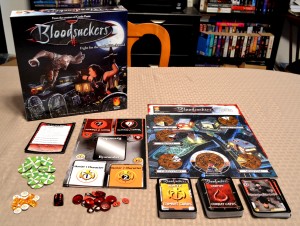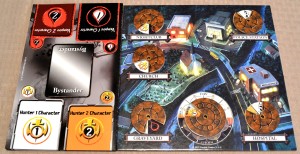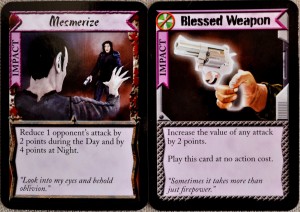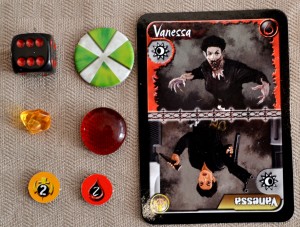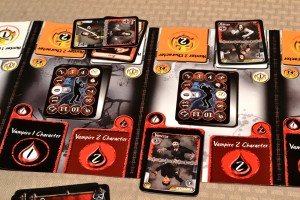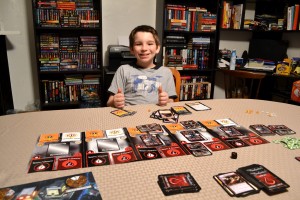The residents of “Blackwood” may want to consider taking an extended vacation, at least until the vampires and vampire hunters are done with the place. In this exciting and thematic game for two to four players, both factions will be fighting for control over key locations throughout the small, peaceful town of “Blackwood”. Will the vampires drain the entire town dry, or will the vampire hunters be successful in fending off these powerful beasts? That’s up to you. Before we get started with the review, I’d like to thank Justin and Anne-Marie De Witt, the co-owners of Fireside Games, for providing me with a free press copy.
*Editor’s Note: Players can opt to play a shorter game by fighting at fewer locations.
Components
Game Board and Mat – The game board serves as a tracker of sorts, listing all of the buildings that the two factions will be fighting over and their current status in terms of who prevailed at each location. The game board also contains a day/night cycle tracker, which makes either faction more powerful for a short period of time. The mat is where the battles will physically take place for each location.
Cards – A number of decks are included in the game, including vampire combat cards, vampire hunter combat cards, character cards, and reference (on your turn) cards. The first two decks I mentioned are unique to each faction, giving them special abilities to employ during combat. Character cards employ a three-sided design with either a vampire or vampire hunter on one side and a tracker on the other.
Tokens & Counters – Various pieces are used to track numerous aspects of gameplay. Vampire and vampire hunters, for example, earn blood and adrenaline tokens (respectively). The game also comes with one, six-sided die.
Setup & Gameplay
Game setup will vary slightly, depending on how many people are playing the game. In a two player game, one player will take on the role of the vampires while the other will assume control of the vampire hunters. In a three or four player game, players will form teams. Each player will receive five combat cards from their faction’s deck to form their hand, five action counters, three character cards, and a reference card. Each faction starts with either one blood token or one adrenaline token in their respective pools. In the event that there are more players on one side than the other, the side who has the disadvantage receives extra cards. The faction who goes first is determined via die roll, with the winner also being able to set the time of day to either dusk or dawn, depending on which faction won.
To sum up the game as a whole, players will be competing in a series of battles. Think of these battles as rounds, in which each round will determine who wins a specific location. A round or battle lasts one full day/night cycle and once a location is won, the results are set in stone. The game board is used to track who won which location, with the battles themselves taking place on the mat. The faction who controls the most locations after the smoke clears is the winner of the game.
At the beginning of a round or battle, the starting player will choose a location. Each location on the game board lists the number of bystanders (tracker side of the character cards) that should be dealt onto the mat. Each player then lays out their character cards on their side of the mat. When it comes time for a particular faction to play, they’ll be alloted three action points. This allows them to do things like draw cards, play combat cards, move characters, and more. Each side will be attempting to move their attack counter as high as they can on each of the bystanders. Whoever has the most bystanders at the end of the battle, wins the location.
A typical “turn” for a faction plays out in the following manner:
1) Spend up to three action points…up to two can be banked, which are tracked via the action tokens.
2) Discard as many cards as desired and draw up to a hand size of five cards.
3) Unstun any characters that may be stunned.
4) Move the day/night cycle tracker ahead one.
Both sides will repeating the above steps, attempting to win locations in order to win the game. I realize that I didn’t cover everything found in the manual, but the above overview should give you an idea as to how the game is played. For more information, please refer to the manual I linked below:
http://www.firesidegames.com/downloads/BloodsuckersRulesWEB.pdf
The Review
The components, I must say, were very eye-catching and colorful. There was an obvious difference between the vampires and vampire hunter factions, unique decks aside. I personally would have prefered a board in place of the mat, though due to how large it is lengthwise I can see why the former wasn’t used (packaging, costs, etc.). The mat still serves its purpose in helping to keep the separate bystanders organized and was of surprisingly good quality. The manual did a good job in detailing the rules, though it is about twenty pages long. While this is standard in a lot of the sixty to ninety minute games in my collection, some families may feel overwhelmed at first. There’s also a bit of a learning curve, especially with how the cards function and interact with one another. I’d highly recommend reserving an extra hour of play time on your first time through.
I really enjoyed the differences between the vampires and vampire hunters when it came time to actually start playing cards. Combat cards consist of attack, impact, strike, and dodge cards…while both decks contain cards all four types, the abilities listed on them are fairly unique. Vampires, for example, have the ability to bite vampire hunters. Left unchecked, the vampire hunter character card will be converted to a vampire, to be used by their faction in the future. Vampire hunters have an equally devastating arsenal, making use of more conventional weapons. I liked the fact that some of the cards could only be played during the day or night.
The combat mechanics employed when dealing with bystanders was an interesting choice. Rather than continually add attack values to the tracker’s current value, you’d simply adopt the new number. I found that this helped to keep the tug-of-war for a particular bystander evenly matched throughout a day. I thought about what the game would be like if the former were true and realized that some cards might allow for a runaway leader, with the other faction having no hope of ever winning back that bystander. There’s still a little luck in drawing some good combat cards to play on bystanders, but the “adopt the new value” mechanic forces players to combine card elements to make the attack value higher than normal. This gave us a reason to care about how the cards worked together.
In terms of whether or not the game is strategic or luck-based in nature, I’d have to say that the game employs a little bit of both. As with most games that employ a deck of unique cards, players are at the mercy of what they draw. With that being said, the ability to pick and choose which bystanders you want to focus on certainly make the game feel more strategic than luck-based. With each side gaining bystanders as the game goes on, there’s a bit more room to manuever. Blood and adrenaline tokens, which are earned by playing strike cards, modify / buff particular characters of your choice. This can help turn the tide and win a particular bystander back into your good graces. So while there is some luck in the cards, there’s a lot of other things going on to keep players from feeling “out of control”.
When it comes down to it, “Bloodsuckers” is the vampire vs hunter game that I’ve always wanted. I’ve enjoyed playing games like “Dracula”, but they tend to ignore or lack that “player versus player” feeling. There are actually two learning curves to overcome…one being getting into the groove of a typical turn while the other involves getting used to how the cards function. The former usually clicks before the latter, so definitely be patient and accept the fact that things won’t be perfect on your first few times through. There’s also some semi-violent card art, so keeping with the age recommendation is a good idea. It’s worth noting that I had no issues letting Vinnie (12) play the game, though every parent must make that determination on their own in regards to letting their own kids play. Deep and highly thematic, “Bloodsuckers” is a must for any vampire/vampire hunter or board game enthusiast.
Final Verdict: 9/10
—
You can learn more about and purchase “Bloodsuckers” by visiting the following websites:
http://www.firesidegames.com/bloodsuckers.html
http://boardgamegeek.com/boardgame/89222/bloodsuckers
—

